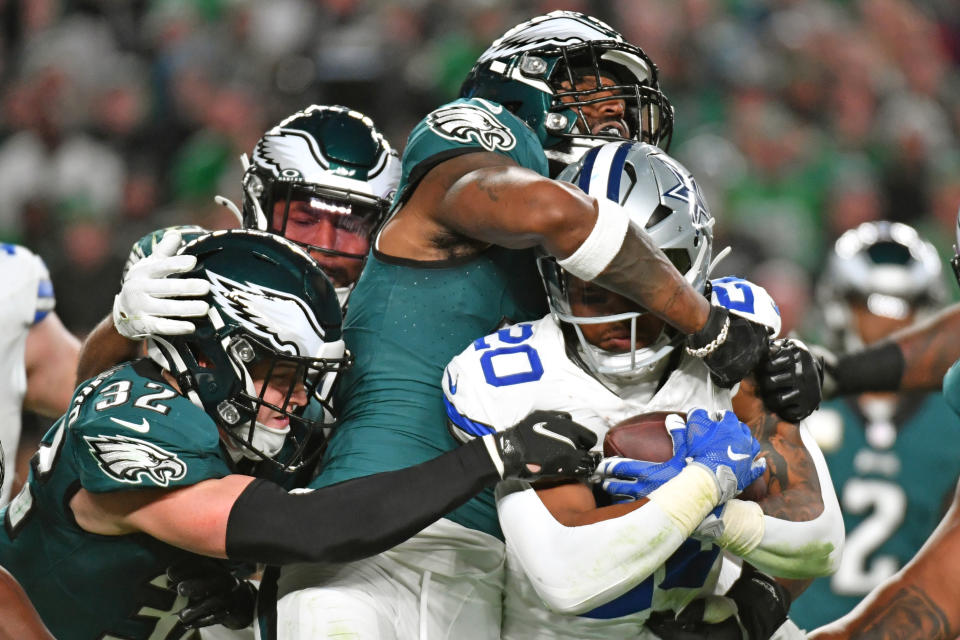Pollard’s performance shows position’s volatile nature for Cowboys

When the Cowboys parted ways with Ezekeil Elliott in the 2023 offseason, many wondered what it would mean for Tony Pollard in Dallas. After four years as Elliott’s understudy, Pollard was scheduled to hit free agency.
The Cowboys had a dilemma on their hands. Would they re-sign Pollard to pick up where Elliott left off? Would they let him test the waters in free agency knowing they had a deep draft class to draw from if they needed to? Or would they split the difference and slap him with the franchise tag? 10 weeks into the 2023 season and the Cowboys are probably happy they did things the way they did.
As we all know, the Cowboys opted for the franchise tag, paying him handsomely but not committing beyond the season.
At a cost of $10,091,000 it was certainly not chump-change they were committing to the RB position. They could have saved money in the immediate if they signed him to a multi-year deal instead because it could have spread the cost into future seasons. They also could have let him walk and rolled the dice with a rookie. They had options.
While nearly everyone in the “Running Backs Don’t Matter Fan Club” agreed the long-term contract wasn’t the way to go, many others around the league questioned Dallas’ handling of the situation.
Pollard was one of the most efficient RBs in the NFL and locking the 26-year-old in for 2-3 years would offer stability through his prime years and would free up money for other contracts in the process.
Life as the alpha is hard

There’s no question life is easier playing second fiddle. The pressure and abuse taken by sitting in the first chair take a toll, both physically and mentally. There’s a reason efficiency stats typically favor the RB2 in most systems and why statistics alone don’t paint an accurate picture in the backfield.
Lead backs have to produce the tough yards. They have to produce the volume yards. They have to convert the short yards. And it often comes at the cost of fresh legs and getting those easy change-of-pace runs throughout the game.
It explains why Pollard went from 5.2 yards/carry in 2022 to 3.9 yards/carry in 2023 and why his backup in 2023 is averaging 4.5 yards/carry behind him.
Pollard as RB2 compared to RB1

While a case can be made Pollard was also the RB1 in 2022, having Elliott next to him taking a near-even share of the workload offered a much different dynamic than this season. In 2022, Pollard took 50.9% of the snap share. In 2023, he’s taking 69.9% of the snap share.
In the all-important rushing yards over expected (RYOE) stat, Pollard went from +0.62 with a +0.01 EPA/play in 2022, to a +0.28 RYOE with a -0.12 EPA/play in 2023.
His breakaway run rate was 8.8% in 2022 and in 2023 it dropped to 4.4%. He was fifth in yards per touch and eighth in yards created per touch in 2022. In 2023 he’s sitting at 36th for yards per touch and 27th for yards created per touch.
Is this decline because he moved into a true lead role or is it just an inevitable decline?
Probably neither.
[affiliatewidget_smgtolocal]
Money doesn’t equal production

At 26, Pollard is his prime, so his slippage isn’t because he’s on the physical decline. His decline in efficiency is more likely attributed to a heavier workload each week. He’s currently eighth in rushing attempts and on pace to blow previous career highs out of the water.
It goes against conventional wisdom but slipping into the true bell cow role hasn’t impacted his box counts negatively. The average number of defenders in the box moved from 6.9 in 2022 to 6.8 in 2023, so if anything, he’s facing easier box counts in his current role, not more.
At 72%, the Cowboys rank seventh in run block win rate as a team. Last season, they were also seventh in the NFL, winning 73% of the time. So while the personnel on the offensive line has changed, the results are almost identical.
Was reading @ericeager_ article where he mentioned RB performance this year. Here is how the RB market lines up with @SumerSports yards created metric and yeah its a rough showing for the expensive players. pic.twitter.com/bVPqD6rauh
— Jason_OTC (@Jason_OTC) November 14, 2023
The reality is, rushing performance is naturally volatile. It’s volitivity is what sparked the running backs don’t matter movement and why RB value has plummeted over the years. It’s not that their role is unimportant – it’s that their performance is often unstable and can largely be duplicated with near replacement level alternatives.
Look no further than Rico Dowdle’s performance this season.
Dowdle is a player who entered camp somewhat on the roster bubble. He was an undrafted free agent and regarded as a replacement level talent in most circles. Yet he’s outperforming Pollard in both yards/carry and EPA/rush.
A couple takeaways here:
1)Tony Pollard is still adding the most value to runs in Dallas
2) Rico Dowdle is getting better blocking which explains his higher y/c. 3) Cowboys are best served reducing TP’s workload so he regains his explosiveness but not 50/50 split pic.twitter.com/yZdO4nGrMn— Reid D Hanson (@ReidDHanson) November 16, 2023
Dowdle isn’t better than Pollard, he’s just a fresh option who happens to have benefited by better blocking with his opportunities. He clearly needs more carries, but it’s not because he’s pushing Pollard, it’s because fresh legs are good for a running game.
The takeaway is even the best RBs can suddenly decline and just because a team pays for elite play, doesn’t mean they’ll get elite play.
Teams who invest heavily in the position often come to regret it while teams who treat RB like a replaceable part often get the most bang for their buck.

